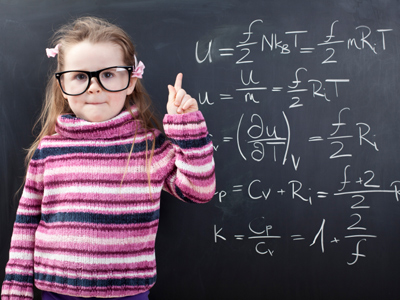
Think before you answer each question.
Level 5-6 Algebra - Equations with Letters on Both Sides
In your KS3 Maths journey, algebra is a part you'll spend a lot of time tackling. Sometimes, you'll face equations with letters on both sides of the equals sign, and that's what this quiz is all about. Remember the handy rule: 'change sides, change signs,' and you'll be on the right track.
Click to See How Quizzes Help Learning
1 .
What is the value of f in the following equation: 7(f - 5) = 4(f - 3.5)?
7
9
11
13
7(f - 5) = 4(f - 3.5) is the same as 7f - 35 = 4f - 14. f must equal 7
2 .
4(a + 7) = 40 is the same as which of the following?
4 - a - 7 = 40
4 - a + 7 = 40
4 + a + 7 = 40
4a + 28 = 40
Multiply the 4 (outside of the brackets) with both the a and the 7 (inside the brackets)
3 .
x + 7 = 10 + 12 is the same as which of the following?
x = 10 + 12 - 7
x = 10 + 12 + 7
x = 17 + 19
x = 70 + 84
When the 7 crosses over to the other side it becomes - 7
4 .
Look at this equation: 10 + 18 = 7x. Now decide which of the following is not correct.
7x = 10 + 18
7x = 10 - 18
7x = 28
x = 4
First get the letter x onto the left hand side and then, in stages, break down its value
5 .
Look at this equation: 10x + 18x = 7x + 189. Now decide which of the following is not correct.
10x + 18x + 7x = 189
10x + 18x - 7x = 189
21x = 189
x = 9
When we rewrite the equation as 10x + 18x - 7x = 189, we've moved the 7x from one side of the equals sign to the other. That means that it changes from a positive to a negative number
6 .
What is the value of c in the following equation: 4c = 2c + 75?
8
37.5
75
150
2c = 75
7 .
2x + 3y = 3y + 7 is the same as which of the following?
2x = 6y + 7
2x = 7
y = 2x - 7
y = 2x + 7
When + 3y crosses over to the other side it becomes - 3y and cancels out the 3y that was already on that side
8 .
What is the value of d in the following equation: 13d + 8 = 7d + 3d + 35?
7
9
11
13
'Write it down and work it out'. There is no alternative to a step by step approach!
9 .
Look at the equation 4(a - 4) = 3a - 9. Now decide which of the following is not correct.
4a - 16 = 3a - 9
a = -9 + 16
a = 7
a = 25
Simplifying equations makes them a lot easier to solve
10 .
What is the value of e in the following equation: 2(e + 5) = 44?
0.7
7
17
27
2(e + 5) = 44 is the same as 2e + 10 = 44 so 2e = 34. 34 divided by 2 = 17
**Unlimited Quizzes Await You! 🚀**
Hey there, quiz champ! 🌟 You've already tackled today's free questions.
Ready for more?
Ready for more?
🔓 Unlock UNLIMITED Quizzes and challenge yourself every day. But that's
not all...
not all...
🔥 As a Subscriber you can join our thrilling "Daily Streak" against other
quizzers. Try to win a coveted spot on our Hall of Fame Page.
quizzers. Try to win a coveted spot on our Hall of Fame Page.
Don't miss out! Join us now and keep the fun rolling. 🎉
**Unlimited Quizzes Await You! 🚀**
Hey there, quiz champ! 🌟 You've already tackled today's free questions. Ready for more?
🔓 Unlock UNLIMITED Quizzes and challenge yourself every day. But that's not all...
🔥 As a Subscriber you can join our thrilling "Daily Streak" against other quizzers. Try to win a coveted spot on our Hall of Fame Page.
Don't miss out! Join us now and keep the fun rolling. 🎉







